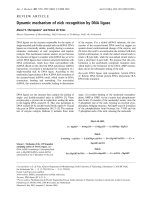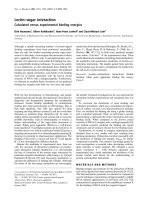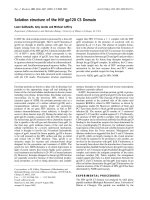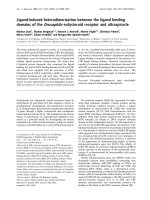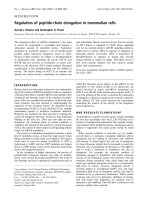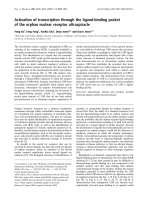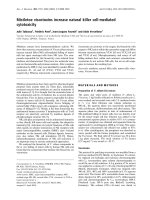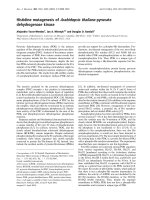Báo cáo Y học: Lectin–sugar interaction Calculated versus experimental binding energies ppt
Bạn đang xem bản rút gọn của tài liệu. Xem và tải ngay bản đầy đủ của tài liệu tại đây (951.75 KB, 7 trang )
Lectin–sugar interaction
Calculated versus experimental binding energies
Dirk Neumann
1
, Oliver Kohlbacher
2
, Hans-Peter Lenhof
2
and Claus-Michael Lehr
1
1
Department of Biopharmaceutics and Pharmaceutical Technology, and
2
Center for Bioinformatics, Saarland University, Saarbru
¨
cken,
Germany
Although a steadily increasing number of protein–ligand
docking experiments have been performed successfully,
there are only few studies concerning protein–sugar inter-
actions. In t his study, w e investigate t he interaction o f w heat
germ agglutinin (WGA) w ith N-acetylglucosamine and a
number of its derivatives and predict the binding free ener-
gies using fl exible docking techniques. To assess the quality
of our predictions, we also determined those binding free
energies exper imentally in cell-binding studies. The predicted
binding site, ligand orientation, and details of the binding
mode are i n p erfect agreem ent with t he known crystal
structure of WGA with a sialoglycopeptide. Furthermore,
we obtained a n excellent linear correlation of our predicted
binding free energies with both our own data and experi-
mental data from the literature [ Monsigny, M ., Roche, A.C.,
Sene, C., Maget Dana, R. & Delmotte, F. (1980) Eur. J.
Biochem. 104, 147–153.]. In both cases, predicted energies
were within 1.0 k JÆmol
)1
of the experimental value. These
results illustrate the usefulness o f docking-based method s for
the qualitative and quantitative prediction of protein–car-
bohydrate interactions. The insights gained f rom such the-
oretical studies may b e used to complement t he results from
the still s carce crystal s tructures.
Keywords: protein–carbohydrate interactions; flexible
docking; wheat germ agglutinin; binding free energy;
Caco-2.
With the f ast development o f biotechnology a nd genetic
engineering in the last decade, the importance o f p roteins f or
diagnostic and therapeutical purposes has considerably
increased. Lectins b inding s pecifically to carbohydrate
residues have been used primarily in cell histology. Due to
their high specificity, they offer new options for drug
targeting and drug delivery systems [1] and have even been
discussed as potential drugs themselves [ 2]. In order to
employ lectins successfully in such systems and to overcome
possible d rawbacks, s uch as immunogenity or toxicity, a
deeper understanding of the sugar–lectin interaction is
crucial. Wheat germ agglutinin (WGA) is a well-known
lectin specific for N-acetylglucosamine and its derivatives. It
has been used in vitro both in transfection studies [3] a nd as a
targeting carrier protein f or a c hemotherapeutic p rodrug [4],
showing its potential in pharmaceutical applications. T he
binding of this lectin to various cell lines [5–7] and ligands
[8–12] was investigated by different methods.
Despite this multitude of experimental data, there are
only few accounts of theoretical predictions of protein–
sugar interaction energies. Bradb rook et al.[13]modeled
the heat of formation of the protein–sugar interaction by
molecular d ynamics s imulations, while Liang et al.[14]and
Pathiaseril & Woods [15] used free-energy simulations to
calculate t he differences in binding free energies. A lthough
the results of the free-energy simulations are encouraging,
the number of ligands investigated so far was small and the
correlation between experimental and calculated data was
poor.
To overcome the d rawbacks of most docking and
evaluation procedures, which may overestimate the import-
ance of outliers, we used a two-step p rocedure for docking.
First, we localized the binding site using a global docking
and a statistical approach. Then, we performed a second,
local docking to determine the correct orientation and exact
binding mode. When compared to the known crystal
structure o f WGA in complex with a sialoglycopeptide [16],
our method correctly predicted the binding site, ligand
orientation and all c ontacts relevant for the binding mode.
Furthermore, we wanted to compare experimental d ata
obtained from in vitro studies with data resulting from
docking calculations. If these data correlate r easonably well,
the prediction of binding free energies DG
bind
for similar
compounds is possible. The e xtensive knowledge g ained by
such investigations is essential when developing carbohy-
drate mimetics or lectin mimetics. We obtained a good
linear correlation (r ¼ 0.96) between calculated and
experimental data, which underlines the usefulness of the
atomic models used herein for t he understanding of
protein–carbohydrate interactions.
MATERIALS AND METHODS
Binding energies and constants f or the interaction of WGA
and various ligands have been reported p reviously [8–10,12].
The thermodynamic parameter we selected for comparison
wastheminimumconcentrationofligandneededtoinhibit
WGA induced agglutination of r ed blood cells [17]. T his
concentration i s proportional t o the equilibrium constant K
for the binding of WGA w ith the respective ligand.
Correspondence to D. Neumann, Saarland University, Bldg. 8.1, 66123
Saarbru
¨
cken, Germany. Fax: + 49 0681 302 4677,
Tel.: + 49 0681 302 3140, E-mail:
Abbreviations: WGA, wheat germ aggluti nin.
(Received 9 October 2 001, rev ised 10 January 2002, accepted 22
January 2002)
Eur. J. Biochem. 269, 1518–1524 (2002) Ó FEBS 2002
In addition to the data from literature, we determined the
concentration of ligand needed to inhibit the binding of
fluorescently labeled WGA (WGA*) to Caco-2
BBe
cell
monolayers by 50% ( IC
50
). The Caco-2
BBe
cloned cell line
was purch ased from the A merican Type Culture C ollection
(ATCC), Manassas, Virginia, USA. The rhodamine labele d
WGA was obtained from Linaris, Wertheim-Bettingen,
Germany. All ligands were from Sigma-Aldrich Chemie
GmbH, Schnelldorf, Germany. The cells were cultured in
75-cm
2
flasks (Greiner Labortechnik GmbH, Frickenhau-
sen, Germany) at 37 °Cin5%CO
2
in 25 m
M
Dulbecco’s
modified Eagle’s medium (DMEM, Sigma-Aldrich) con-
taining 10% fetal bovine serum, 1% nones sential amino
acids. Approximately 16 0 00 cells were seeded per well in
96-well plates (Greiner Labortechnik). The medium was
changed three times a week. Monolayers were used for
experiments five days postconfluence.
Inhibition of WGA binding to fixed Caco-2
BBe
cells
Caco-2
BBe
cells were cultured on 96-well plates to 5 days
postconfluence. Because the amounts of WGA found in
Caco-2 cells increase with time even at temperatu res as low
as 4 °C (Fig. 1), we used fi xed c ells. The monolayers were
washed with Ca
2+
-free buffer, fixed in buffer c ontaining
2.5% glutaraldehyde and washed again. Solutions contain-
ing both 18 lgÆmL
)1
fluorescently labeled WGA and
inhibitor at varying concentrations were given to the
monolayers. The cells were incubated at room temperature
for 1 h before washing them again to remove unbound
lectin. The remaining fluorescence was measured and
plotted v s. the natural logarithm of concentration o f the
ligand. The point-of-inflection of a sigmoidal fit of t his c urve
gave the concentration needed to in hibit 50% of maximum
binding (IC
50
, see Fig. 2).
Theoretical study of binding to WGA
The binding energies between the flexible ligands and the
large acceptor molecule were calculated using
AUTODOCK
3.0 [18–20], an atom-based docking simulation program. To
accomplish a quick energy evaluation,
AUTODOCK
precal-
culates g rid-based m olecular affinity potentials. For e ach
atom type in the substrate molecule, a different three-
dimensional g rid map is generated b y assigning the energy
of interaction of a single probe atom to the grid point.
Similarly, a grid for the electrostatic potential is calculated.
The ligand is d efined by a r igid root, from which rotatable
bonds sprout. The program features different search
methods (simulated annealing, genetic search algorithms,
and loc al searc h), from which w e s elected the Lamarckian
genetic algorithm. This algorithm starts the docking process
with a random population o f a limited number of individ-
uals. T hese individuals represent molecules with uniformly
distributed random values for torsion angles, quaternions,
and translation vectors. The values for torsion angles,
quaternion, and translation vectors represent the genes of
an individual and can be inherited by the upcoming
population.
Some of the ligands undergo a local search b efore the
energy of each individual i s calculated to determine how
many offspring i t will produce i n the following generation.
Finally, a two-point crossover and mutations are performed
on random members of t he population r esulting in new
ligand positions and conformations. Ad ditionally, e litism
was used to let some individuals with the best energies
survive unchanged into the next g eneration.
Ligand preparation
For our docking experiments we chose s everal well-known
ligands, for which concentrations to inhibit red blood cell
agglutination induced by WGA have been reported in
literature or are accessible by experiment: a-N-acetyl-
neuraminic acid (NeuNAc, CAS: 131-48-6), N-acetyl-b-
D
-
galactosamine (GalNAc, CAS: 1421 5-68-0), N-acetyl-b-
D
-
glucosamine (GlcNAc, CAS: 7512-17-6), methyl-N-acetyl-
b-
D
-glucosamine (Me-GlcNAc, CAS: 3946-01-8), N,N¢-
diacetylchitobiose [the b(1–4)-dimer of GlcNAc, CAS:
35061-50-8], p-nitrophenyl-N-acetyl-a-
D
-galactosaminide
Fig. 1. Amounts of WGA* found in Caco-2
BBe
cell monolayers in
dependence of incubation time and temperature. The cells were incuba-
ted with 100 lL buffer containing WGA* at a concentration of
50 lgÆmL
)1
. S imilar curves w ere observed for lower a nd higher lectin
concentrat ions.
Fig. 2. Inhibition of the binding of fluorescently labeled WGA* to
Caco-2
BBE
cells by GlcNAc. The point-of-inflection corresponds to
50% inhibition (IC
50
).
Ó FEBS 2002 Lectin–sugar interaction (Eur. J. Biochem. 269) 1519
(CAS: 23646-68-6, a-NPhGalNAc), p-nitr ophenyl-N-
acetyl-b-
D
-galactosaminide (CAS: 14948-96-0, b-NPhGal-
NAc), p-nitrophenyl-N-acetyl-a-
D
-glucosaminide (CAS:
10139-02-03, a-NPhGlcNAc) , and p-nitrophenyl-N-acetyl-
b-
D
-glucosaminide (CAS: 3459-18-5, b-NPhGlcNAc).
NeuNAc was modeled as the a-anomer, because this form
is predominant in solution [ 21] and only this conformation
was reported to bind t o WGA [22 ]. Galactose (Gal), which
is known not to bin d to WGA, was used as a con trol for our
calculations.
All ligand structures were built using
HYPERCHEM
6.01 [23] assuming pyranosyl ring-conformations. These
starting structures were optimized with a series of restricted
Hartree–Fock (RHF) quantum-mechanical calculations of
increasing accuracy. I n a first step, the ge ometries of the
built structures were optimized using the semiempirical
PM3 method [24,25]. The resulting structures were then
optimized using ab initio methods subsequently employing
the small 3-21G basis set [26] and the larger 6-31G* [27]
basis set. For the final conformations we calculated 6–
31G* electrostatic potential derived c harges (ESP charges).
The semiempirical computations were performed using
MOPAC
[28], while the ab initio calculations were performed
using
GAMESS
[29].
Receptor
The s tructure of WGA was taken from the crystal structure
of WGA in complex with a sialoglycopeptide available at
the Protein DataBank [30] (PDB accession no. 2CWG).
Water a nd ligands were removed from t he crystal structure.
To this initial structure hyd rogen atoms were added and
their positions optimized using the
AMBER
force field
(parm94) [31]. These calculations were performed with t he
HYPERCHEM
6.01 program [23]. In order to simplify the
evaluation, the lectin was rotated such that the principal
axes of the protein coincided with those of the Cartesian
system.
Docking
In order to m odel hydrogen bon ds, polar and nonpolar
hydrogens were u sed f or both ligand and receptor r esulting
in two different hydrogen maps. Parameters for pairwise
atomic interaction e nergies were taken from the
AUTODOCK
3.0 User G uide, while the elec trostatic interaction e nergy
was calculated using a sigmoidal distance-dependent
dielectric function [32]. The well depths for the original
Lennard-Jones, electrostatic, hydrogen bonding, and d es-
olvation potential fu nctions were scaled according to
Morris et al. [20] in order to improve the accuracy of the
prediction of binding free energies. During the docking
process, the t orsion angles for ring s ystems were kept fixed,
while all other groups were freely rotatable to allow the
formation of as many hydrogen bonds as possible. Using
the Lamarckian genetic algorithm, each docking run
started with a random population of 10 individuals per
dihedral. T he number of energy evaluations was 30 000 per
individual. All other docking parameters were set accord-
ing to Morris et al . [20]. Each docking run resulted in
exactly one ligand conformation, which of all generated
conformations provided the best interaction energy with
WGA.
To assess the suitability of
AUTODOCK
for determining the
binding site for carbohydrates, both GlcNAc a nd the N,N¢-
diacetylchitobiose (GlcNAc-dimer) were subjected to 1000
docking runs using large grid maps of 200 · 14 5 · 145
points with a grid-point spacing of 0.575 A
˚
.Thesegrid
maps were centered on the middle of the wheat germ
agglutinin dimer and encompassed the whole l ectin and an
additional shell of 20 A
˚
.
For the calculation of the binding energies and to
elucidate the binding modes, grid maps with
101 · 101 · 101 points a nd a g rid-point spacing o f
0.375 A
˚
were used. The maps were centered on the S
BC
binding site of WGA. The ligands were subjected to 100
docking runs resulting in 100 conformations.
Determination of the binding site
To exclude outliers from further evaluation, we gathered
statistical i nformation about the most p robable binding site
for each ligand. Because the exact orientation in the
binding pocket is not crucial information for determining
the l ocation of the binding site, only the position of the
center of gravity of the six-membered sugar ring was
evaluated instead of the positions of all atoms of each
docked ligand. Furthermore, the distance from ligand to
protein center was neglected, because WGA offers only
shallow binding sites, so the ligand i s always met on the
surface o f t he protein. This simplification allows switching
from three Cartesian coordinates to the two angles o f p olar
coordinates with t he protein center serving as the o rigin of
the system.
The binding site was l ocalized by using a two dimensional
Gauss distribution analysis. The frequency of occurrence for
a ligand docking to a s pecific site was c alculated by applying
a density function to the polar an gles / and h:
P
B
ðu; hÞ¼
1
N
X
N
i¼1
e
ÀðuÀu
i
Þ
2
þðhÀh
i
Þ
2
r
2
Here, N is the total n umber of runs, (/
i
,h
i
) are the ligand
coordinates of a run, and r is the half-width of the peak and
was set to 5°.
Employing this kind o f density function to a set of
docking runs results in a binding site map, where each point
(/,h) i n two-dimensional polar angle space is assigned a
value P
B
(/,h), which c an be seen as a likelihood of a binding
site being at this position (although it is not normalized).
Plotting of P
B
, for example using contour lines, results in
what we call a binding site map ( Fig. 3B). In this kind of
map, binding sites clearly show as high peaks. The polar
angle coordinates of a peak correspond to the l ocation of
the binding site with respect t o the protein center.
For the docking of GlcNAc and i ts dimer to WGA, t he
highest peaks observed coincide with the positions of the
sialic acid residue of the T 5 sialoglycopeptide from t he
crystal structure 2CWG [16], which was used for compar-
ison (Fig. 3B). The C
2
symmetry shows up well in the
binding site map: subtracting 180° from the / coordinate of
a peak leads to a peak of s imilar h eight, which corresponds
to the symmetry-related binding site.
To determine the binding free energies for comparison
with experimental data, we c onsidered all docking runs
ending within a distance b elow 5° from the h ighest peak
1520 D. Neumann et al. (Eur. J. Biochem. 269) Ó FEBS 2002
observed. Of these conformations from the global-local
search, the one with the lowest binding free energy was
subjected to 100 local docking runs allowing a maximum
translation i n x, y,andz direction of ± 1.5 A
˚
. For a t ypical
distance betwee n ligand and lectin center of 2 5 A
˚
, a change
of 5° in a polar angle translates to a displacement of the
ligand coordinates of approximately 2 .1 A
˚
.
RESULTS
Experimental IC
50
values for the binding of WGA
to fixed Caco-2
BBe
cells
Using the techniques described i n t he previous section, we
determined the IC
50
for GalNAc, GlcNAc, NeuNAc,
a-NPhGlcNAc, b-NPhGalNAc, N,N¢-diacetylchitobiose,
a-NPhGalNAc, and b-NPhGlcNAc.Wewereableto
obtain a good sigmoidal fit for each ligand ( similar t o the
one seen in Fig. 2). Table 1 contains the corresponding IC
50
values and their s tandard deviations obtained from t hree
repeated experiments.
Theoretical prediction of the binding site
In order to test the ability of
AUTODOCK
to locate the
binding site, GlcNAc and N,N¢-diacetylchitobiose were
subjected to 1000 docking runs in large grid maps covering
the whole lectin p lus a shell o f 20 A
˚
. The binding site maps
for these two ligands accurately predict all four binding sites
of WGA: the four highest peaks coincide with the coordi-
nates for the binding sites of the sialoglycopeptide in the
crystal structure (see Fig. 3 B).
For a more accurate prediction of th e various ligands’
conformations and binding energies, each ligand was
docked in a smaller grid centered on the binding site S
BC
[33], w hich Wright or iginally called t he primary b inding site
[22]. We considered only the conformer corresponding to
the lowest interaction energy from all i ndividuals produced
by the docking runs for further evaluation. This conformer
was t hen subjected to a local search, which resulted in more
robust energies, especially for the highly flexible ligands
N,N¢-diacetylchitobiose and N-acetylneuraminic acid.
Binding mode
As the binding free energies are highly dependent on the
correct prediction of the bound structure of a ligand and an
accurate prediction of all interactions involved, we carefully
compared the predicted binding mode of N-acetyln euram-
inic acid with the known crystal structure [16]. The root
mean square deviation of the positions of all heavy atoms of
the docked N-acetylneuraminic acid, including the fl exible
glycerol side chain, from the c oordinates r eported in the
crystal structure is 1.8 A
˚
, which is well within the 2.0 A
˚
resolution of the crystal structure (Fig. 4). All interactions
described i n t he original publication by Wright [22] are also
present in the predicted s tructure.
We then examined and compared the binding character-
istics of the various ligands based on t he structures obtained
from the best docking results. The b inding of the ligands is
primarily mediated by hydrogen bonds formed between
C ¼ O and Ser62
II
, N-H and Glu115
I
,C
3
-O and Ser43
II
,
C
4
-OH and Ser43
II
and C
4
-O and Ser114
I
,andahydro-
phobic interaction of the methyl g roup with Tyr73
II
as well
Table 1. IC
50
values ± s tandard deviation obtained by inhibiting the b inding of fluorescently labeled W GA to fixed Caco-2
BBe
cells by various ligands.
All values are giv en in m
M
.
Ligand IC
50
±SD(
M
) Hemagglutination (
M
)
a
GalNAc 2.1 · 10
)1
± 0.97 · 10
)1
2.0 · 10
)1
GlcNAc 2.0 · 10
)2
± 0.23 · 10
)2
1.0 · 10
)2
NeuNAc 1.3 · 10
)2
± 0.09 · 10
)2
6.0 · 10
)2
a-NPhGlcNAc 5.9 · 10
)4
± 0.9 · 10
)4
–
b-NPhGalNAc 5.3 · 10
)4
± 2.8 · 10
)4
3.0 · 10
)3
N,N¢-Diacetylchitobiose 4.1 · 10
)4
± 0.3 · 10
)4
4.0 · 10
)5
a-NPhGalNAc 4.0 · 10
)4
± 0.4 · 10
)4
1.0 · 10
)3
a
From Monsigny et al. [17].
Fig. 3. Comparison of (A) scatter and (B) Gauss plot for the docking of
GlcNAc to WGA. (B) T he higher the probability to find a ligand at a
certain position, the h igher the observed peak. The highest peaks
coincide with the locations of the binding sites of the NeuNAc residue
as observed in the crystal structure. The S
BC
(ÔprimaryÕ)andS
AD
(ÔsecondaryÕ) bindin g si te s a re located at A (/ ¼ 126°, h ¼ 28°),
A¢ (/ ¼ ) 54°, h ¼ 28°)andB(/ ¼ ) 10°, h ¼ ) 53°), B¢ (/ ¼
170°, h ¼ ) 53°), resp ectively.
Ó FEBS 2002 Lectin–sugar interaction (Eur. J. Biochem. 269) 1521
as a stacking o f t he glycopyranoside r ing with Tyr66
II
.This
stacking is a feature often observed in protein–saccharide
interactions [34]. A similar situation is observed for the
binding of NeuNAc, for which our calculations suggest a
lower binding affinity than for GlcNAc due to the highly
charged carboxylic group. In comparison to the crystal
structure, the calculations show the six-membered ring
deeper in the binding pocket, which a llows for a more
pronounced stacking of the NeuNAc w ith the Tyr66
II
and
establishing an ad ditional hydrogen bond with Glu115
I
.All
other i nteractions are preserved except f or the hydrophobic
interaction between the NeuNAc and Tyr64
II
.Inthecaseof
GalNA c, the C
4
atom does not establish any distinct
hydrogen bonds: the difference in bin ding energy between
GalNAc and GlcNAc i s about 1.8 kJÆmol
)1
.
Nonpolar groups bound to C
1
may establish a hydro-
phobic contact with a tyrosine residue (Tyr64
II
). The
GlcNAc-dimer and all p-nitrophenyl d erivatives e xert a
second stacking with Tyr64
II
with a distance between the
centers of the ring s ystems of 5.5 A
˚
and 3 .8 A
˚
, r espectively.
The GlcNAc-dimer forms additional hydrogen bonds
resulting in a difference in binding free energy between
GlcNAc and the GlcNAc-dimer of about 3.6kJÆ mol
)1
.The
sugar rings of t he p-nitrophenyl derivatives are tilted with
respect to the positio n of GlcNAc resultin g in variations in
the hydrophobic and electrostatic interactions of the
p-nitrophenyl group with the tyrosine residue Tyr64
II
.The
p-nitrophenyl group of a-NPhGalNAc points slightly
downwards, which leads to a good stacking with Tyr64
II
residue and a favourable electrostatic interaction with the
hydroxyl group of Tyr64
II
residue. As for t he b-p-nitrophe-
nyl derivatives, the aromatic rings are parallel to Tyr64
II
,
but the p-nitro groups point away from the hydroxyl group
exerting a lesser electrostatic interaction w ith the hydroxyl
group of this residue than the a-NPhGalNAc, which
explains the lower calculated affinity to WGA. The
aromatic ring of a-NPhGlcNAc points downward but is
off-center, which leads t o a decreased hydrophobic i nterac-
tion. In addition, the N O
2
group o f this ligand is even more
distant f rom the hydro xyl group of the T yr64
II
residue than
those of the b-p-nitrophenyl derivatives. The hydrophobic
interaction of Me-GlcNAc with the Tyr64
II
is less pro-
nounced than for the p-nitrophenyl derivatives and there is
no additional electrostatic interaction. This results in a
calculated binding free energy only slightly lower than that
of a-NPhGlcNAc.
Binding energies
The binding free energies from our docking calculations
were plotted vs. the natu ral logarithms of minimum
concentration of ligand needed to inhibit red blood cell
agglutination b y WGA as reported by Monsigny et al.[17].
The highest binding free energy calculated was )12.47
kJÆmol
)1
for the interaction of WGA with Gal, which served
as a control. An excellent linear correlation between
calculated and experimental data with a slope of
0.66 ± 0.08 k JÆmol
)1
; a correlation coefficient r ¼ 0.96
(Fig. 5) was obtained.
Plotting our calculated interaction energies vs. the
natural logarithm of the corresponding IC
50
determined
by inh ibiting th e binding of WGA* to fixed Caco-2
BBe
cells
resulted in a linear correlation with a slope of 0.64 ±
0.11 kJ Æmol
)1
and a correlation coefficient r ¼ 0.92
(Fig. 6). Closer examination reveals that the deviation
fromthelinearfitislargestfor(GlcNAc)
2
. B ecause our
prediction for the binding energies of th e other ligand s fits
nicely to t he values of Monsigny et al. [17], it s eems likely
that the observed IC
50
value for (GlcNAc)
2
is an outlier.
The inhibition concentration we should expect to see is
very low (approximately 2.0 · 10
)5
molÆL
)1
), so binding to
the surface or possibly even t he inside of the cells might
cause t he observed increment in inhibitory concentration
for this ligand without impacting t he values for the less
potent inhibitors. Assuming (GlcNAc)
2
to be an outlier,
the correlation coefficient improves to r ¼ 0.97. Except
for G lcNAc
2
, a ll data points were within ± 0.6 k JÆmol
)1
of
the linear fit.
Fig. 4. Comparison of crystal structure and docking results for the
binding of N-acetylneuraminic acid to WGA. Theligandisrenderedas
sticks, the lectin surface is rendered in blue. (A) The NeuNAc acid
residue from the c rystal structure of WGA i n complex with a s ialo-
glycopeptide is shown. The ligand exhibits a stacking with Tyr 64
II
and
Tyr66
II
. (B ) The docked ligand fits snugly into the b ind ing pocket of
WGA. In comparison with the crystal structure, the ligand establishes
more hy drogen bonds and a more p ronounced stacking w ith Tyr66
II
,
while no stac king with T yr64
II
is observed.
1522 D. Neumann et al. (Eur. J. Biochem. 269) Ó FEBS 2002
CONCLUSIONS
Because our goal is the development of carbohydrate
mimetics or lectin mimetics for pharmaceutical purposes,
we want to establish a method to correlate theoretical
binding free energies with data from in vitro experiments.
The fixed Caco-2
BBe
cells allow the inve stigation the
inhibition of the binding o f WGA to cell s urface receptors
and to determine relative binding affinities. The main
advantage of fixed cells is that the a mount of WGA i nside
the cells does not increase with increasing incubation time;
nonetheless, analogous experiments may be e asily carried
out using live cells. Ligands with little inhibitory power
have to be used in high concentrations, which may
eventually lead to considerable volume changes. To
overcome this drawback, we used a low lectin concentra-
tion, which is not feasible for l ectins with smaller affinities
to this cell line, because the fluorescence determination of
these bound lectins is very difficult. However, we consider
fixed cells a useful tool to determine relative binding
energies especially with regard to deve loping lectinomimet-
ics for pharmaceutical pur poses.
The accuracy of the predicted binding free energies
came as a surprise to us because most docking programs
still have problems p redicting important contributions to
the binding free energy, especially the e ntropic c ontribu-
tions. Still, we could show a linear correlation between
calculated binding energies and data f rom literature as
well as our o wn experiments . It might b e argued, that this
linear correlation is based on the entropy–enthalpy
compensation, which was reported for the binding of
GlcNAc and its oligom ers t o WGA and its B- domain [12,
34]. The entropy-enthalpy compensation leads to a linear
relation between binding free energy and heat of binding.
This relation is usually interpreted such that hydrogen
bonding and van der Waals forces are considered to
contribute to the formation of the complex, while
rigidification of the ligand and lectin side chains as well
as solvation effects have been discussed a s c ounteracting
the binding. On the other hand, the parameters of
AUTO-
DOCK
were explicitly modified by Morris et al.[20]to
enable the calculation of binding free energies by including
solvation parameters, which probably account for a
significant fraction of the entropic e ffects. Our calculated
difference in binding free energy between GlcNAc and
N,N¢-diacetylchitobiose is 3.6 kJÆmol
)1
, which is close to
the experimental value of 5.9 kJÆmo l
)1
as determined by
microcalorimetry [12].
The good correlation of experimental and calculated data
emphasizes the suitability of the empirical binding free
energy function of
AUTODOCK
3.0aswellastheatomic
approach to calculating interaction energies. Thus, we
should be able not only t o reproduce, but also to predict t he
relative interaction energies of d iffering small ligands with a
lectin.
Finally, we presented a new and easy method to
determine the most probable docking sites by plotting
docking probabilities vs. polar coordinates of t he ligand,
allowing quick visualization o f data from docking calcula-
tions. These binding site maps offer a much clearer o verview
than the commonly used scatter plots and make it much
easier to identify the binding sites unambigously. The
importance o f outliers is lessened because the evaluation is
based on the number of ligands docking to a certain site.
Moreover, small ligands may bind in different orientations
and conformations into the binding pocket. Usin g only t he
coordinates o f the center of gravity, the exact orientation of
the ligand is not evaluated, so this evaluation method is
superior to clustering procedures based on the root mean
square deviation of all atom coo rdinates, when it comes to
determining a binding site.
In summary, our study shows that theoretical methods
based on flexible docking, if carefully applied, can yield
interesting insights into the details of the protein–
carbohydrate interactions. Although less reliable than
ÔhardÕ, experimental d ata, the results of such prediction
are a valuable complement to the still rather limited
number of crystal structures. Whether the approach is
transferable to other lectins as well will be the subject of
further studies.
Fig. 6. Correlation be tween our calculated energies and our experi-
mental IC
50
for i nhibiting the binding of fluorescently la beled wheat germ
agglutinin to Caco-2
BBe
cells. (GlcNAc)
2
was not in cluded in the fit
shown.
Fig. 5. Correlation b etween c alculated e nergies and minimum concen-
trations needed to inhibit horse red blood cell agglutination induced by
wheat germ agglutinin [17]. A linear correlation between binding
energies and inhibitory c oncentrations was shown.
Ó FEBS 2002 Lectin–sugar interaction (Eur. J. Biochem. 269) 1523
ACKNOWLEDGEMENTS
D. N. wishes to thank the ÔLandesgraduiertenfo
¨
rderung des SaarlandesÕ
for giving him the opportunity to conduct this research. O. K . was
supported by the DFG research cluster ÔInformatikmethoden zur
Analyse und Interpretation grosser g enomischer DatenmengenÕ,grant
LE952/2-1.
REFERENCES
1. Lehr, C.M. (2000) Lectin-mediated drug delivery: the second
generation of bio adhe sives. J. Controlled Release 65 , 19–29.
2. Beuth, J., Ko, H.L., Gabius, H.J . & Pulverer, G. (1991) Influence
of treatment with the immunomodulatory effective dose of the
beta-galactoside-specific lectin from mistletoe on t umor coloniza-
tion in BALB/c-mice for two experimental m odel systems. In Vivo
5, 29–32.
3. Yin, W. & Cheng, P W. (1994) L ectin conjugate-directed gene
transfer to airway epithelial cells. Bio chem. Biophys. R es. Commun.
205, 826–833.
4.Wirth,M.,Fuchs,A.,Wolf,M.,Ertl,B.&Gabor,F.(1998)
Lectin-mediated drug targeting: p reparation, b inding ch aracter-
istics and antiproliferative activity of wheat germ agglutinin
conjugated doxorubicin in CACO-2 cells. Pharm. Res. 15, 1031–
1037.
5. Aubery, M ., Reynier, M., Lopez, M ., Ogier Denis, E., Font, J. &
Bardin, F. (1990) WGA binding to the surface of two a utologou s
human melanoma cell lines: different expression of sialyl and
b-acetylglucosaminyl residues. Cell. Biol. Int. R eport 14, 275–286.
6. Gabor, F., Stangl, M. & Wirth, M. (1998) Lectin-mediated
bioadhesion: binding characteristics of plant lectins on the
enterocyte-like cell lines Caco-2, HT-29 and HCT-8. J. Controlled
Release 55 , 131–142.
7. Lotan, R., Sharon, N. & M irelman, D. (1975) Interaction o f
wheat-germ aggl utinin with bacterial cells and cell-wall polymers.
Eur. J. Biochem. 55, 257–262.
8. Nagata, Y. & Burger, M.M. (1974) Wheat germ agglutinin.
Molecular characteristics and specificity for sugar binding. J. Biol.
Chem. 249 , 3116–3122.
9. Privat,J.P.,Delmotte,F.&Monsigny,M.(1974)Protein–sugar
interactions. Association o f beta-(1,4) linked b-acetyl-
D
-glucosa-
mine oligomer derivatives with wheat germ agglutinin (lectin).
FEBS Lett. 46, 224–228.
10. Midoux, P ., Grivet, J.P., Delmotte, F . & Monsigny, M. ( 1984) The
binding of monosaccharides to wheat germ agglutinin: fluores-
cence and NMR investigations. Bioc hem. Biophys. Res. Commun.
119, 603–611.
11. Kronis,K.A.&Carver,J.P.(1985)Thermodynamicsofwheat
germ agglutinin–sialyloligosaccharide interactions by proton
nuclear magnetic re sonance. Biochemistry 24, 834–840.
12. Bains, G., Lee, R.T., Lee, Y.C. & Freire, E. (199 2) Microcalori-
metric study of wheat germ agglutinin binding to b-acetyl-
glucosamine a nd its o ligomers. Biochemistry 31 , 12624–12628.
13. Bradbrook, G.M., Forshaw, J.R. & Perez, S. (2000) Structure/
thermodynamics relationships of lectin-saccharide complexes:
the E rythrina corallodendron case. Eur. J. Biochem. 267, 4545–
4555.
14. Liang, G., Schmidt, R.K., YuH A., Cumming, D.A. & B rady,
J.W. (1996) Free energy simulations studies o f the b inding specifity
of mannose-bind ing protein. J . Phys. Chem. 100, 2 528–2534.
15. Pathiaseril, A. & Woods, R.J. (2000) Relative energies of binding
for a ntibody – carbohydrate-antigen complexes computed from
free-energy simulations. J. Am. Chem. Soc. 12 2, 331–338.
16. Wright, C.S. & Jaeger, J. (1993) Crystallographic r efinement and
structure analysis of the complex of whe at germ agglutinin with a
bivalent sialoglycopeptide from glycophorin A. J. Mol. Biol. 232,
620–638.
17. Monsigny, M., Roche, A.C., Sene, C., Maget Dana, R. &
Delmotte, F . (1980) S u gar–lectin i nte raction s: h ow does wheat-
germ agglutinin bind sialo glycoconjugates? Eur. J. Bioc hem. 104,
147–153.
18. Goodsell, D.S. & Olson, A.J. (1990) Automated docking of
substrates to proteins by sim ulated annealing. Proteins 8, 195–202.
19. Morris, G.M., Goodsell, D.S., Huey, R. & Olson, A.J. (1996)
Distributed automated docking of flexible ligands to proteins:
parallel applications of AutoDock 2.4. J. Comp. Aided Mol. Des.
10, 293–304.
20. Morris, G.M., Goodsell, D.S. & Halliday, R.S. (1998) Automated
docking using a Lamarckian genetic algorithm and an empirical
binding free e nergy function. J. Comput. Chem. 19, 1639–1662.
21. Brown, E.B., Brey, W.S. & Weltner, W. Jr (1974) Cell-surface
carbohydrates and their interactions. I. NMR of b-acetyl
neuraminic acid. Biochim. Biop hys. Acta 399, 124–130.
22. Wright, C.S. (1980) Crystallographic elucidation of the saccharide
binding m ode in wheat ge rm agglutinin and i ts biological signifi-
cance. J. Mol. Biol. 141, 267–291.
23. Reference w ithdrawn .
24. Stewart, J.J.P. (1989) Optimization of parameters for semi-
empirical methods I. Method. J. Comput. Chem. 10, 209–220.
25. Stewart, J.J.P. (1989) Optimization of parameters for semiempir-
ical methods II. Applications. J. Comput. Chem. 10, 221–264.
26. Binkley, J.S., Pople, J.A. & Hehre, W.J. (1980) Self-consistent
molecular o rbital methods. 21. Small split-valence basis sets for
first-row elements. J. Am. C he m. Soc. 102 , 939–947.
27. Hariharan, P.C. & Pople, J.A. (1973) Polarization functions
for the 6-31G* and 6-31G ** basis sets. Theoret. Chim. Acta 28,
213–222.
28. Stewart, J.J.P. (1990) MOPAC: a s emiempirical molecular orbital
program. J. Com put Aided Mol. Des. 4, 1–105.
29. Schmidt, M.W., Baldridge, K.K., Boatz, J.A., Elbert, S.T.,
Gordon, M.S., Jensen, J .H., Koseki, S., Matsunaga, N., Nguyen,
K.A., Su, S.J., Windus, T.L., Dupuis, M. & Montgomery, J.A.
(1993) G eneral atomic and molecular e lectronic structure system.
J. Comput. C he m. 14, 1347–1363.
30. Berman, H.M., Westbrook, J., Feng, Z., Gilliland, G., Bhat, T.N.,
Weissig, H., Shindyalov, I.N. & Bourne, P .E. (2000) The Protein
Data Bank. Nucleic Acids Res. 28, 235–242.
31. Cornell, W.D., Cieplak, P., Bayly, C.I., Gould, I.R., Merz, K.M.,
Ferguson, D.M., Spellmeyer, D.C., Fox, T., Caldwell, J.W. &
Kollman, P.A. (1995) A second generation force field for the
simulation of proteins, nucleic acids, and organic molecules.
J. Am. Che m. Soc. 117 , 5179–5197.
32. Mehler, E.L. & Solmajer, T. (1991) Electrostatic effects in
proteins: comparison of dielectric and charge models. Protein Eng.
4, 903–910.
33. Kronis,K.A.&Carver,J.P.(1985)Wheatgermagglutinindimers
bind sialyloligosaccharide s at four sites i n solution: p roton nuclear
magnetic resonance t emperature studies at 360 MHz. Biochemistry
24, 826–833.
34. Espinosa, J.F., Asensio, J.L., G arcia, J.L., Laynez, J ., Bruix, M.,
Wright, C ., Siebert, H.C., Gabius, H.J., Canada, F.J. & Jimenez
Barbero, J. (2000) N MR investigations of protein–carbohydrate
interactions binding studies an d refined three-dimensional solution
structure of the complex between the B domain of wheat germ
agglutinin and N,N¢,N¢-triacetylchitotriose. Eur. J. Biochem. 267 ,
3965–3978.
1524 D. Neumann et al. (Eur. J. Biochem. 269) Ó FEBS 2002
